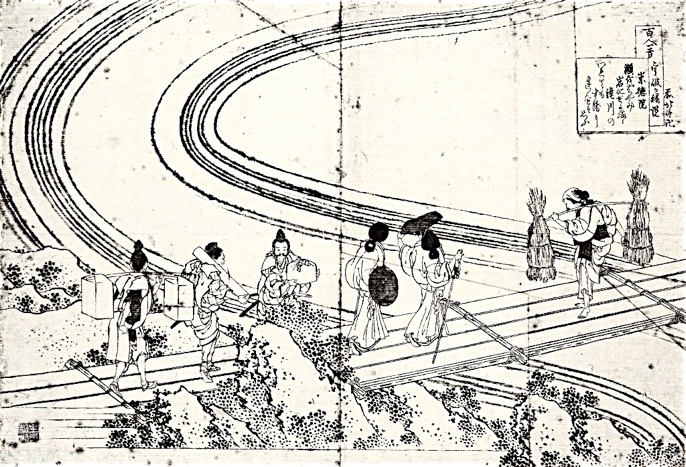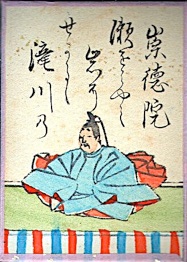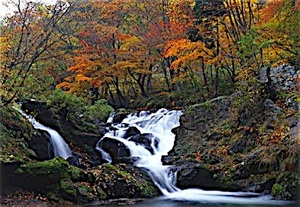崇徳院御製

瀬をはやみ
岩にせかるる
滝川の
われても末に
逢はむとぞ思ふ
すとくいん
せをはやみ
いわにせかるる
たきがわの
われてもすえに
あわんとぞおもう
Emperor Sutoku
Though a swift stream
Sprung apart by a boulder,
The flow of the rapids,
First divided, in the end
Unites again, I know.
Hokusai
Emperor Sutoku (1119 - 1164) reigned from 1123 to 1142. Sutoku (‘worshipping virtue’) was his posthumous name. His personal name was Akihito (written differently from the present emperor’s name). He was exiled to Sanuki province (now Kagawa, on the Shikoku island) when his side lost in the Hogen rebellion, and later became a monk. After his death he was considered an onryo, a vengeful ghost, in some legends in which the rise of the samurai power was blamed on him. To pacify his ghost a temple, the Komyoin Kanshoji, was erected in 1177 in Kyoto where his residence had once been and he was deified in the Konpira shrine here built much later by emperor Meiji following a wish of emperor Komei (Japanese site).
He had commissioned Akisuke (poem 79) to edit the Shikashu, the sixth imperial anthology, in which many of his poems were published.




Could the poet be referrring to his wish that he be reinstalled as emperor, making Tadamichi (poem 76) the personification of the rock that prevented this? Or was it a simple observation of nature, or does it refer to the Buddhist belief in the unity of all things, or was it a love poem after all?
The Yasui Konpira shrine is now located at the site of the Komyoin Kanshoji where Minamoto Yorimasa and emperor Sutoku, arch-enemies, were both deified and ‘peacefully reunited’. Here you can find a rock that is considered to unite lovers (and the reverse if wanted, but that is another story). It is possible that this poem is related to the rock. Sutoku’s mausoleum is just a bit north-west of this shrine, in the 大中院 (see Google Earth companion).
Hokusai’s drawing represents one stream with pronounced left and right sides. On the bridge we see a lady with her retinue, and a peasant woman coming from the other direction. Both are looking at the stream, both are ‘united’ on the bridge. The lady could be going to an amorous rendezvous, but that is not conclusive. Hokusai could have drawn an allegory of the population, aristocracy and peasantry, looking for unity in government.
